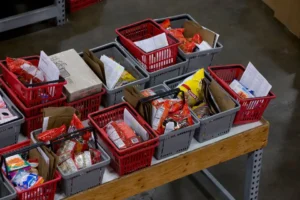Guide to Understanding the Prison Commissary Menu
In The Corrections sector, the prison commissary serves as a vital lifeline for inmates. It’s where they can purchase essential items that aren’t provided by the correctional institution.
This guide will delve into the ins and outs of the prison commissary menu, exploring what’s available, how it works, and its impact on the daily lives of inmates.
Let’s get to know more,
What is a Prison Commissary?
The prison commissary is essentially a store within the correctional facility where inmates can purchase various items. It operates on a weekly or bi-weekly basis, depending on the facility, and offers a range of goods from food and hygiene products to clothing and electronics.

Understanding the prison commissary Menu
1. Food Items
One of the most important categories in the commissary menu is food. Inmates can purchase snacks, drinks, and sometimes even ready-to-eat meals. This provides them with additional sustenance beyond what is served in the cafeteria. Popular items include:
– Snacks: Chips, cookies, candies, and ramen noodles.
– Beverages: Coffee, tea, soft drinks, and sometimes juice.
– Condiments: Ketchup, mustard, and mayonnaise.
– Canned Goods: Tuna, beans, and soup.
2. Hygiene and Personal Care
Maintaining personal hygiene is crucial in a correctional facility. The commissary provides a variety of hygiene products, including:
– Soap and Shampoo: Basic toiletries for cleanliness.
– Toothpaste and Toothbrush: Dental hygiene essentials.
– Deodorant: To control body odor.
– Feminine Hygiene Products: Sanitary napkins and tampons.
3. Clothing and Footwear
While uniforms are typically provided, commissaries often offer additional clothing items such as:
– Socks and Underwear: Basic essentials.
– Shoes: Sometimes limited to basic sneakers or slip-ons.
4. Electronics and Communication
In some facilities, inmates can purchase basic electronics to help pass the time or communicate with family:
– Radios: Portable radios to listen to news or music.
– MP3 Players: Sometimes allowed for personal music enjoyment.
– Tablets: Limited use for email or educational purposes.
How Does It Work?
The process of accessing the commissary and making purchases can vary by facility. Generally, inmates are given a weekly spending limit based on their behavior and privileges. They can place orders through a form or an electronic system and receive their items during designated distribution times.
Impact on Inmates
The commissary can significantly affect an inmate’s quality of life:
– Nutritional Supplementation: Helps supplement the often bland and repetitive meals served in the cafeteria.
– Emotional Well-being: Provides a sense of autonomy and normalcy amidst the prison environment.
– Social Currency: Items from the commissary can be used for bartering and building relationships among inmates.
Challenges and Controversies
Despite its benefits, the commissary system isn’t without criticism:
– Costs: Prices in commissaries are often higher than retail, making it harder for inmates from low-income backgrounds.
– Security Concerns: Some items can be misused or repurposed for illicit activities.
– Inequality: Inmates with access to funds from the outside have more purchasing power, creating disparities.
FAQs
1. How often can inmates shop at the commissary?
Inmates can usually shop at the commissary once a week or once every two weeks, depending on the rules of the facility.
2. What can inmates buy from the commissary?
Inmates can buy a variety of items, including snacks like chips and cookies, beverages, hygiene products like soap and toothpaste, basic clothing like socks and underwear, and sometimes electronics like radios or MP3 players.
3. How do inmates pay for commissary items?
Inmates typically pay for commissary items using funds deposited into their commissary account. These funds can come from their earnings in prison jobs, money sent from family or friends, or other sources.
4. Why is the commissary important to inmates?
The commissary is important because it allows inmates to access items that improve their quality of life in prison. It provides a sense of normalcy, helps supplement the prison diet with additional snacks and personal care items, and allows for some level of personal choice and autonomy in their daily lives.
Conclusion
The prison commissary menu is like a essential store for inmates, providing them with things they need but can’t get from the prison itself. It gives them a taste of everyday life and helps them feel more normal.
Learning how it works helps us see what life is like for people in prison and the problems they deal with every day. Exploring the commissary menu helps us understand the challenges of life behind bars and how important these items are for inmates.




